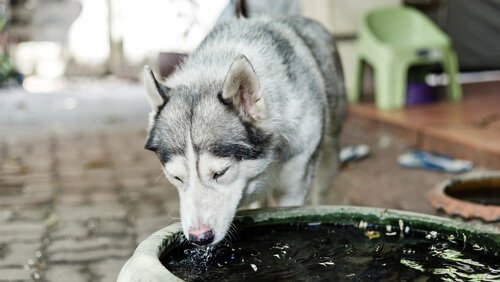How to Take Care of my Dog During High Temperatures?

There are many doubts about whether or not you should use a fan for your dog when summer brings high temperatures. Do you want to know the answer? It is true that direct air tends to bother your dog, but they get hot, like us.
Even though a dog’s fur protects him from both high and low temperatures, that does not mean he does not suffer. Moreover, as his skin does not perspire, a dog is more likely to suffer from heat stroke and dehydration than a human.
Therefore, if your dog is not bothered by the direct air from a fan, you can use this to cool him down. It is more likely that your dog will appreciate the gesture than be bothered by the air.
Should I use a fan to protect my dog from high temperatures?
There are many ways to prevent your dog from suffering the consequence of high temperatures. Always take steps to prevent your dog from suffering with heat stroke.
To truly enjoy a dog, you should not try to train him to be semi-human. The point is to open yourself to the possibility of being more like a dog.
–Edward Hoagland–
The first thing you should do is to avoid putting your dog in high-temperature situations that could cause heat stroke. For example:
- Do not leave your dog in the car. Some people go on a shopping spree, take their dog and leave it in the car, with the windows closed or open just a crack. We will tell you this: closed or open, the greenhouse effect is the same. The car will get very hot and your dog could die. The best thing is to leave your pet at home.
- Do not take your dog out at times with super high temperatures. This is another common failure. It is true that your dog must go out three times a day, but the time routines have to change from summer to winter. In summer, you can not take your dog out at a time when it is too hot, because the animal could be harmed.
- Do not leave your dog tied in the direct sun. There are those who either leave their dog at the door of the supermarket in the hot sun, or those who want their dog to live on a terrace or a balcony, where there is no shade. There have even been cases where dogs try to flee from this harmful situation, by throwing themselves off the balcony.
In addition to setting up a fan for your dog, take into account these tips:
- Avoid letting your dog become overweight. If your pet is overweight, he will be more prone to heat stroke, and being overweight could even cost him his life. Put your pet on a diet to prevent this from happening.
- Consider your breed. There are dogs of specific breeds that are more likely to suffer when there are high temperatures. Also, older dogs and puppies are more delicate.
- Use air conditioning. Air conditioning is also good for dogs, so if you have it at home, do not be afraid to use it. All the myths that dogs get cold or that the air conditioner will bother them, are not true.
- Put on the fan. This depends on how your dog reacts to the fan. Some dogs are frightened, others hate direct air and some enjoy the fan. You know your pet better than anyone. So, ask yourself if your dog enjoys the fan? You can respond according to his personality.
What to do in the face of heat stroke
If you see that your dog is suffering from heat stroke, follow these tips:

- Give him ice. If you have ice on hand or there is a place to buy it, do not hesitate. Put ice on your dog’s head, neck and belly. These are the three places of the body that suffer the most from heat stroke.
- Give him water. If there is no ice, but you do have water, pour it over his head and give him a drink. Do not force it, let your dog drink as much as he can.
- When you get home, a cold shower will help, even if your dog has already recovered.
There are many doubts about whether or not you should use a fan for your dog when summer brings high temperatures. Do you want to know the answer? It is true that direct air tends to bother your dog, but they get hot, like us.
Even though a dog’s fur protects him from both high and low temperatures, that does not mean he does not suffer. Moreover, as his skin does not perspire, a dog is more likely to suffer from heat stroke and dehydration than a human.
Therefore, if your dog is not bothered by the direct air from a fan, you can use this to cool him down. It is more likely that your dog will appreciate the gesture than be bothered by the air.
Should I use a fan to protect my dog from high temperatures?
There are many ways to prevent your dog from suffering the consequence of high temperatures. Always take steps to prevent your dog from suffering with heat stroke.
To truly enjoy a dog, you should not try to train him to be semi-human. The point is to open yourself to the possibility of being more like a dog.
–Edward Hoagland–
The first thing you should do is to avoid putting your dog in high-temperature situations that could cause heat stroke. For example:
- Do not leave your dog in the car. Some people go on a shopping spree, take their dog and leave it in the car, with the windows closed or open just a crack. We will tell you this: closed or open, the greenhouse effect is the same. The car will get very hot and your dog could die. The best thing is to leave your pet at home.
- Do not take your dog out at times with super high temperatures. This is another common failure. It is true that your dog must go out three times a day, but the time routines have to change from summer to winter. In summer, you can not take your dog out at a time when it is too hot, because the animal could be harmed.
- Do not leave your dog tied in the direct sun. There are those who either leave their dog at the door of the supermarket in the hot sun, or those who want their dog to live on a terrace or a balcony, where there is no shade. There have even been cases where dogs try to flee from this harmful situation, by throwing themselves off the balcony.
In addition to setting up a fan for your dog, take into account these tips:
- Avoid letting your dog become overweight. If your pet is overweight, he will be more prone to heat stroke, and being overweight could even cost him his life. Put your pet on a diet to prevent this from happening.
- Consider your breed. There are dogs of specific breeds that are more likely to suffer when there are high temperatures. Also, older dogs and puppies are more delicate.
- Use air conditioning. Air conditioning is also good for dogs, so if you have it at home, do not be afraid to use it. All the myths that dogs get cold or that the air conditioner will bother them, are not true.
- Put on the fan. This depends on how your dog reacts to the fan. Some dogs are frightened, others hate direct air and some enjoy the fan. You know your pet better than anyone. So, ask yourself if your dog enjoys the fan? You can respond according to his personality.
What to do in the face of heat stroke
If you see that your dog is suffering from heat stroke, follow these tips:

- Give him ice. If you have ice on hand or there is a place to buy it, do not hesitate. Put ice on your dog’s head, neck and belly. These are the three places of the body that suffer the most from heat stroke.
- Give him water. If there is no ice, but you do have water, pour it over his head and give him a drink. Do not force it, let your dog drink as much as he can.
- When you get home, a cold shower will help, even if your dog has already recovered.
All cited sources were thoroughly reviewed by our team to ensure their quality, reliability, currency, and validity. The bibliography of this article was considered reliable and of academic or scientific accuracy.
- Flournoy, W. S., Wohl, J. S., & Macintire, D. K. (2003). Heatstroke in dogs: pathophysiology and predisposing factors. Compendium: continuing education for veterinarians, 25(6), 410-418.
- Bruchim, Y., Loeb, E., Saragusty, J., & Aroch, I. (2009). Pathological findings in dogs with fatal heatstroke. Journal of comparative pathology, 140(2-3), 97-104.
This text is provided for informational purposes only and does not replace consultation with a professional. If in doubt, consult your specialist.







